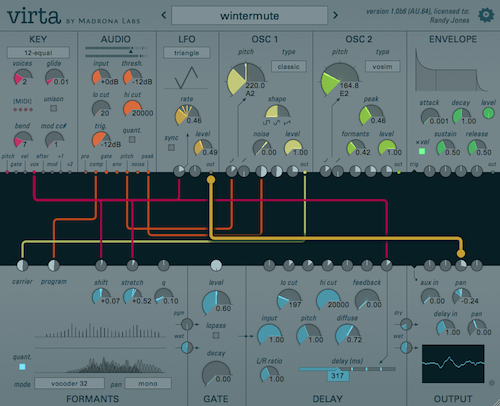Here are some notes I took over the last year as I worked out different aspects of Virta, my new voice-controlled synthesizer. Virta was a set of ideas floating around since four years ago and a conversation I had with a producer friend of mine. He had been talking to another friend who we’ll call DJ X, a person whose records I liked, with a room full of classic synths and a head full of musical ideas, but who nevertheless said what he was wanting most was to just sing and vocalize, play around with mouth sounds, and have that turned into music. This got me thinking about pitch detection and vocoders, and spectral analysis, and modulars...
So the project was in the back of my mind for a while, and there were lots of precedents. I have had lots of fun over the years putting voice and instruments and drum loops into synthesis boxes with pitch trackers. The Korg X-911 comes to mind as the most fun toy specifically designed for this. Its big brother the MS-20 is surely capable of a wider range, however. There's also the Roland SYB-3, a little "bass synthesizer" that was always flat and "bad digital" sounding but fun anyway. And, again from Boss / Roland, the RSD-10, a primitive digital delay/sampler with a pitch tracking control input, designed to let any keyboard control its (two second!) sample using sound as the interface. With a modern pitch detector and other analysis tools, and the patchable interface of Aalto to use, I knew I could make something fun in this department, capable of unlocking some new sounds.
After releasing Kaivo I decided that whatever this was, would be the next Madrona Labs product, and I started learning a lot about pitch detection, spectral analysis, and about the voice in general. Things I remembered from my linguistics classes in my first year of college were actually useful, which is always nice. I built software components like a compressor, pitch shifter, diffuser, vocoder, and periodicity and pitch detectors.
The name was hard. I went through ideas like voco (pretty much taken), kantos (taken), kantu (Esperanto for sing, sounds kind of wrong) and similar things and you know what? Voice and singing is a popular subject and anything good and short to do with it is probably snapped up already. So I started thinking laterally a bit, about the signal flow and patching, and virta came up almost immediately, and I knew it was right. It wraps up a trilogy with aalto and kaivo so nicely—in Finnish, aalto, kaivo and virta mean wave, well, and stream respectively. Virta also means stream in the sense of electrical current.
I've been having so much fun making patches for this friendly new monster. Though it's capable of wild new sounds, it also has a range of bread+butter, simple effects, and I hope that the patchable interface will make it a great tool to reach for in these less fabulous applications too. I'm excited to hear what you do with it.
Virta will be on sale here starting Monday, March 28, for $89.
Brilliant news. I can now rest over the weekend and stop checking in every five minutes!!!
From what I have heard so far it will be great. Have a great easter break!. Best. S
I'm here to help. You have a good weekend too.
congratulations... looking forward to trying this out, hopefully it will make the soundplane sing :)
Congrats, Randy! It looks and sounds amazing (even on the webcast!). Any idea what you'll set the normal price to afterwards? Will it be similarly priced as Kaivo? Just curious. Thanks.
Is it only an effect, or can it be a synth solely with MIDI input?
The manual is online now at http://madronalabs.com/media/virta/images/VirtaManual.pdf . Short answer: all of the above.
I have no idea about future price changes.
I look forward to hearing audio samples of this interesting plugin. And great write-up regarding the history of voice-controlled synthesis. :-) Great work! Shan
Fantastic news, and congratulations, Randy! Looking forward to playing with it on Monday!
In 1986, a friend and I pooled our funds to buy a Korg SDD 1000 and, after a period of fear and trembling (we were broke, and it seemed really expensive), we hacked it to add CV control of the playback rate. This was not pitch detection by any means--and it wasn't calibrated to anything in particular--but it did give us a way to transpose the sample. Hours of harmless fun.
Thanks,
Ole
Great news. As mentioned before I can't wait to get my hands on Virta. Already reading the manual.
Have a nice weekend, Randy.
Very much appreciate being able to follow the development of the project -- from the graph paper schematic that circulated to the glimpses posted by others in the community and finally, your summary text and the photo of your notes above. Best wishes!
Now, back to the soundplane!
Super excited about this. I've also been one of those people checking back here all the time. Thanks for doing cool things!
woo hoo ... can't wait to try it out!
It's been the 28th for17 hours here in Europe... Wake up! Go to the computer and press go!
I'm very excited by this:) Obviously!
Me too ! A dear friend let me on to this and I've been checking your site all - european - day. Simply so turned on to try the "First-ever faithful emulation of the mating call of the Space Pony"! AaaaauuuuuuuUiiiiichi
my body is ready.
yup, its a long wait for us here in europe :)
but its 8:30 there now, so hopefully we just need to wait for Randy to have his morning coffee, and then hit the big green button.
Me too.Greeting from china.here is 29th now.can't sleep before it out~
Sorry, that was a bit difficult for unexpected reasons!
Insta-bought. Warmest congratulations on the release!
Bought! Thanks Randy!

